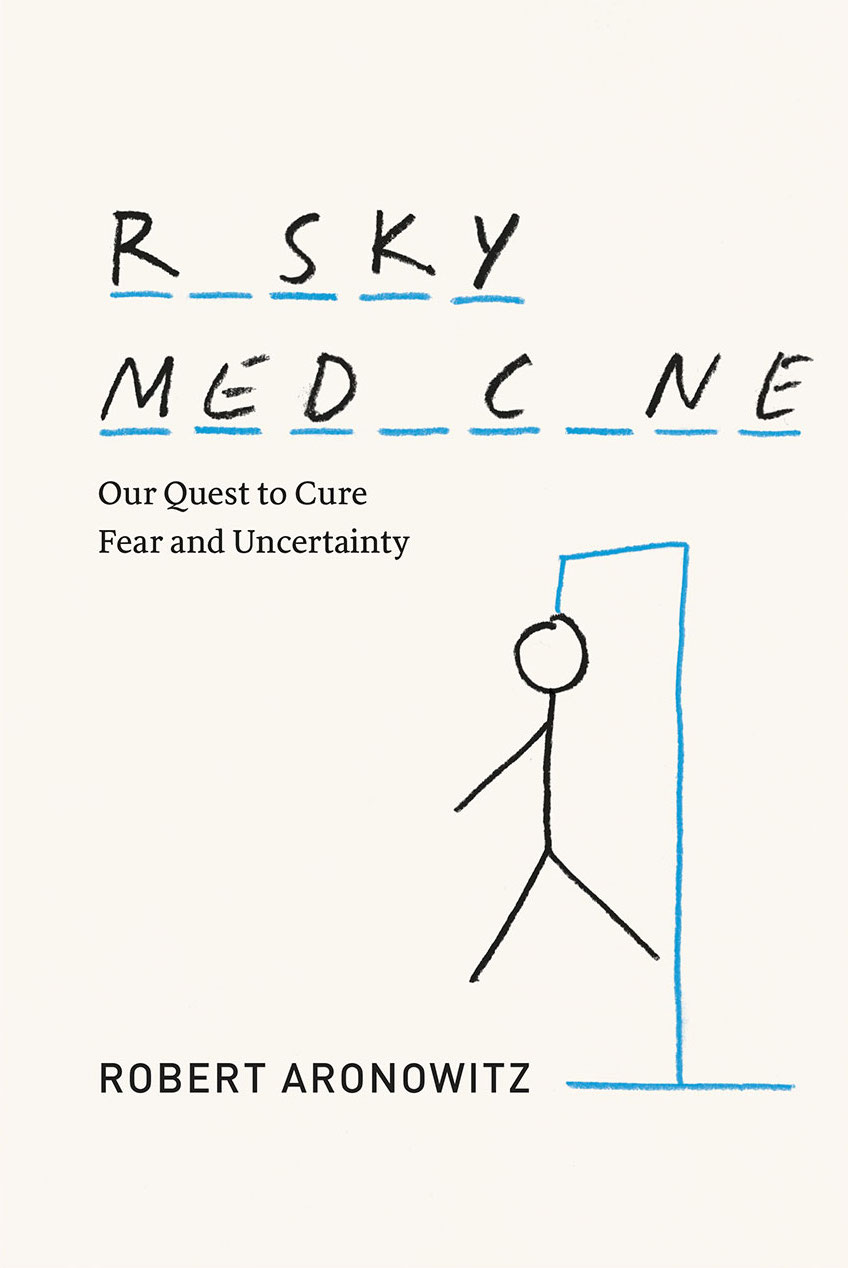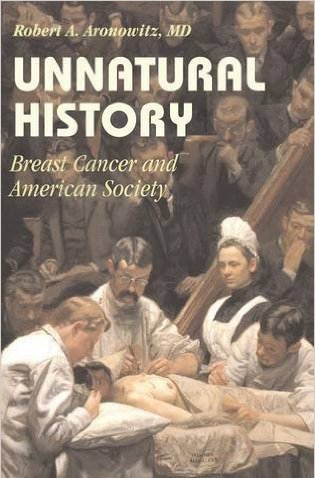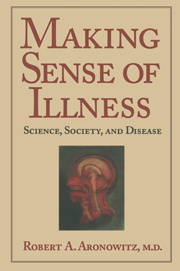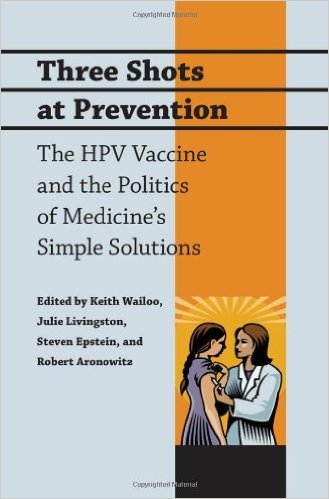Robert Aronowitz
Physician and historian of medicine and science
Books.
Risky Medicine
Our Quest to Cure Fear and Uncertainty

Risky Medicine
Will ever-more sensitive screening tests for cancer lead to longer, better lives? Will anticipating and trying to prevent the future complications of chronic disease lead to better health? Not always, says Robert Aronowitz in Risky Medicine. In fact, it often is hurting us.
Exploring the transformation of health care over the last several decades that has led doctors to become more attentive to treating risk than treating symptoms or curing disease, Aronowitz shows how many aspects of the health system and clinical practice are now aimed at risk reduction and risk control. He argues that this transformation has been driven in part by the pharmaceutical industry, which benefits by promoting its products to the larger percentage of the population at risk for a particular illness, rather than the smaller percentage who are actually affected by it. Meanwhile, for those suffering from chronic illness, the experience of risk and disease has been conflated by medical practitioners who focus on anticipatory treatment as much if not more than on relieving suffering caused by disease. Drawing on such controversial examples as HPV vaccines, cancer screening programs, and the cancer survivorship movement, Aronowitz argues that patients and their doctors have come to believe, perilously, that far too many medical interventions are worthwhile because they promise to control our fears and reduce uncertainty.
Risky Medicine is a timely call for a skeptical response to medicine’s obsession with risk, as well as for higher standards of evidence for risk-reducing interventions and a rebalancing of health care to restore an emphasis on the actual curing of and caring for people suffering from disease.
- Publication: The University of Chicago Press
- Year: 2015
Unnatural History
Breast Cancer and American Society

Unnatural History: Breast Cancer and American Society
In the early nineteenth century in the United States, cancer in the breast was a rare disease. Now it seems that breast cancer is everywhere. Written by a medical historian who is also a doctor, Unnatural History tells how and why this happened. Rather than there simply being more disease, breast cancer has entered the bodies of so many American women and the concerns of nearly all the rest, mostly as a result of how we have detected, labeled, and responded to the disease. The book traces changing definitions and understandings of breast cancer, the experience of breast cancer sufferers, clinical and public health practices, and individual and societal fears.
- Publication: Cambrdige University Press
- Year: 2007
Making Sense of Illness
Science, Society and Disease

Making Sense of Illness: Science, Society and Disease
Making Sense of Illness is a fascinating investigation into the social and clinical factors that determine what constitutes a "legitimate" illness in the twentieth century. By examining six case studies of diseases that have emerged within the past fifty years--from what we now consider to be "straightforward" diseases such as coronary heart disease, to the currently widely-debated Chronic Fatigue Syndrome--Aronowitz examines the historical and cultural factors that influence how doctors think about illness; how illnesses are recognized, named, classified, and finally, what they "mean" in an individual and social context. The choices that are available to the investigators, clinicians, patients and the processes by which change occurs are factors that all play a great role in "legitimizing" an illness, and these are the roles that are seldom examined. By juxtaposing the histories of each disease, Aronowitz shows how cultural and historical precedents have determined research programs, public health activities, clinical decisions, and even the patient's experience of illness. This is a must-read for anyone interested in public health and the history of medicine in the United States.
- Publication: Cambrdige University Press
- Year: 1999
Three Shots at Prevention
The HPV Vaccine and the Politics of Medicine's Simple Solutions

Three Shots at Prevention: The HPV Vaccine and the Politics of Medicine's Simple Solutions
In 2007, Texas governor Rick Perry issued an executive order requiring that all females entering sixth grade be vaccinated against the human papillomavirus (HPV), igniting national debate that echoed arguments heard across the globe over public policy, sexual health, and the politics of vaccination. Three Shots at Prevention explores the contentious disputes surrounding the controversial vaccine intended to protect against HPV, the most common sexually transmitted infection. When the HPV vaccine first came to the market in 2006, religious conservatives decried the government's approval of the vaccine as implicitly sanctioning teen sex and encouraging promiscuity while advocates applauded its potential to prevent 4,000 cervical cancer deaths in the United States each year. Families worried that laws requiring vaccination reached too far into their private lives. Public health officials wrestled with concerns over whether the drug was too new to be required and whether opposition to it could endanger support for other, widely accepted vaccinations. Many people questioned the aggressive marketing campaigns of the vaccine's creator, Merck & Co. And, since HPV causes cancers of the cervix, vulva, vagina, penis, and anus, why was the vaccine recommended only for females? What did this reveal about gender and sexual politics in the United States? With hundreds of thousands of HPV-related cancer deaths worldwide, how did similar national debates in Europe and the developing world shape the global possibilities of cancer prevention? This volume provides insight into the deep moral, ethical, and scientific questions that must be addressed when sexual and social politics confront public health initiatives in the United States and around the world.
- Publication: Johns Hopkins University Press
- Year: 2010
Selected Papers.
Contingent Knowledge and Looping Effects — A 66-Year-Old Man with PSA-Detected Prostate Cancer and Regrets
Robert Aronowitz, M.D., and Jeremy A. Greene, M.D., Ph.DThe New England Journal of Medicine , 2019; 381:1093-1096 || Link
A 66-year-old man with PSA-detected prostate cancer undergoes prostatectomy that leaves him impotent — a decision he regrets when new evidence becomes available. How can the largely social processes by which we identify diseases transform diseases themselves?
Cultural reflexivity in health research and practice
Aronowitz, Robert; Deener, Andrew; Keene, Danya; Schnittker Jason; Tach, LauraAmerican Journal of Public Health , 2015, 105 Suppl 3:S403-8 || Link
Recent public health movements have invoked cultural change to improve health and reduce health disparities. We argue that these cultural discourses have sometimes justified and maintained health inequalities when those with power and authority designated their own social practices as legitimate and healthy while labeling the practices of marginalized groups as illegitimate or unhealthy. This "misrecognition," which creates seemingly objective knowledge without understanding historical and social conditions, sustains unequal power dynamics and obscures the fact that what is deemed legitimate and healthy can be temporally, geographically, and socially relative. We use examples from research across multiple disciplines to illustrate the potential consequences of cultural misrecognition, highlight instances in which culture was invoked in ways that overcame misrecognition, and discuss how cultural reflexivity can be used to improve health research and practice.
From skid row to main street: the Bowery Series and the transformation of prostate cancer, 1951-1966
Aronowitz, Robert,
Bulletin of the History of Medicine, 88.2 (2014): 287-317 || Link
Between 1951 and 1966, more than twelve hundred homeless, alcoholic men from New York's skid row were subjected to invasive medical procedures, including open perineal biopsy of the prostate gland. If positive for cancer, men typically underwent prostatectomy, surgical castration, and estrogen treatments. The Bowery series was meant to answer important questions about prostate cancer's diagnosis, natural history, prevention, and treatment. While the Bowery series had little ultimate impact on practice, in part due to ethical problems, its means and goals were prescient. In the ensuing decades, technological tinkering catalyzed the transformation of prostate cancer attitudes and interventions in directions that the Bowery series' promoters had anticipated. These largely forgotten set of practices are a window into how we have come to believe that the screen and radical treatment paradigm in prostate cancer is efficacious and the underlying logic of the twentieth-century American quest to control cancer and our fears of cancer.
The rise and fall of the Lyme disease vaccines: a cautionary tale for risk interventions in American medicine and public health
Aronowitz, Robert,Milbank Quarterly, 2012, 90 (2):250-277 || Link, Download PDF
Context:Two vaccines to prevent Lyme disease (LD) were developed and tested in the 1990s. Despite evidence of their safety and efficacy in clinical trials and initial postmarketing surveillance, one vaccine was withdrawn before the regulatory review and the other after only three years on the market. An investigation of their history can illuminate (1) the challenges faced by many new risk-reducing products and practices and (2) the important role played by their social and psychological, as distinct from their biomedical or scientific, efficacy in how they are used, and their ultimate market success or failure.
Methods: This article reviewed medical and popular literature on LD vaccines, analyzed the regulatory hearings, and conducted interviews with key participants.
Findings: Even if proved safe and effective, LD vaccines faced regulatory and market challenges because the disease was geographically limited, treatable, and preventable by other means. Pharmaceutical companies nevertheless hoped to appeal to consumers' desire for protection and control and to their widespread fear of the disease. The LD advocacy community initially supported the vaccines but soon became critical opponents. The vaccines' success was seen as threatening their central position that LD was chronic, protean, and difficult to treat. The activists' opposition flipped the vaccines' social and psychological efficacy. Instead of the vaccines restoring control and reducing fear, demand was undermined by beliefs that the vaccines caused an LD-like syndrome.
Conclusion: The social and psychological efficacy of many risk-reducing practices and products, such as new "personalized vaccines," is to provide insurance and reduce fear. Yet the actions of self-interested actors can easily undermine this appeal. In addition to evaluating the scientific efficacy and safety of these practices and products, policymakers and others need to understand, anticipate, and perhaps shape the potential social and psychological work they might do..
The Framingham Heart Study and the Emergence of the Risk Factor Approach to Coronary Heart Disease: 1947-1970
Aronowitz, Robert,Revue d'Histoire des Sciences, 2012, 64: 263-295 || Link
The Framingham heart study is generally considered to be the first large modern cohort study of chronic disease and the major impetus for recognizing different coronary heart disease (CHD) risk factors. Using interviews with Framingham investigators and documents from the planning and early years of the study, I demonstrate that the novel methodological aspects of the study emerged without a great deal of individual agency or consciousness. Beginning as a cardiac control program similar to many older tuberculosis public health campaigns, Framingham investigators innovated in small steps in response to its changing institutional base, the needs of its various supporters and audiences, and new concepts and tools. While Framingham was crucial in uncovering CHD risk factors, the study was itself shaped by many of the same social influences which were leading to a more individualistic and quantitative style of understanding and intervening in CHD and other chronic diseases.
Decision Making and Fear in the Midst of Life
Aronowitz, Robert,
The Lancet, Volume 375, 9724: 1430 - 1431, 2010 || Link
The converged experience of risk and disease
Aronowitz, Robert,Milbank Quarterly, 2009, 87(2): 417–442 || Link
Context: One underappreciated consequence of modern clinical and public health practices is that the experience of being at risk for disease has been converging with the experience of disease itself. This is especially true for certain chronic diseases, in which early diagnosis and aggressive treatment have led to symptom-less and sign-less disease and in which treatments have largely been aimed at altering the disease's future course.
Methods: This article reviews the historical scholarship and medical literature pertinent to transformations in the chronic disease and risk experiences.
Findings: The experience of chronic disease increasingly resembles or has become indistinguishable from risk because of (1) new clinical interventions that have directly changed the natural history of disease; (2) increased biological, clinical, and epidemiological knowledge about the risk of chronic disease; (3) the recruitment of larger numbers into chronic disease diagnoses via new screening and diagnostic technology and disease definitions; (4) new ways of conceptualizing efficacy; and (5) intense diagnostic testing and medical interventions.
Conclusions: The converged experience of risk and disease has led to some unsettling and generally underappreciated consequences that might be subjected to more clinical and policy reflection and response: (1) some puzzling trends in medical decision making, such as the steep and uniform increase in the numbers of women across a broad spectrum of risk/disease in breast cancer who have opted for prophylactic mastectomies; (2) a larger and highly mobilized disease/risk population, resulting in an expanded market for interventions and greater clout for disease advocates; (3) shifts in the perceived severity of the disease, with ripple effects on how people experience and understand their illness and risk of disease; and (4) interventions that promise both to reduce the risk of disease and to treat its symptoms.
Framing disease: an underappreciated mechanism for the social patterning of health
Aronowitz, Robert,Social Science & Medicine, 2008, 67 (1): 1-9 || Link
The emerging fields of social epidemiology and population health seek to understand the social determinants of health. Especially, with regards to how income inequality causes health disparities, attention has been focused on material and psychosocial mechanisms. I use examples from the epidemiological and social science literature to argue for a third broad etiological framework: the role played by the ways we generally recognize, define, name, and categorize disease states and attribute them to a cause or set of causes. These framing effects shape population health by influencing: health and illness beliefs; patterns of consumption and other behaviors; perceptions of what interventions and policies work; class, ethnic, and other social dynamics; and clinical and public health practices. Important characteristics of many framing phenomena are their capacity to be self-perpetuating and their performative power. A better understanding of framing effects can lead to deploying them more deliberatively and flexibly to improve individual and population health.
Do not delay: Breast cancer and Time, 1900-1970
Aronowitz, Robert,Milbank Quarterly, 2001; 79 (3): 355-386 || Link
Until the 1960s, the central public health message about breast cancer was that women should not delay seeking medical attention for breast problems. Epidemiological, pathological, public health, and clinical writings, movies, and doctor-patient correspondence are analyzed in order to understand the durability and centrality of this “do not delay” message. Problematic assumptions about the natural history of cancer, the efficacy of surgery, and individual responsibility for disease contributed to the durability of the “do not delay” message. More important, the message catalyzed or sustained changes in the routines of ordinary women, general practitioners, surgeons, and pathologists, which led to the perception that the campaign against cancer was working. Thus a powerful set of reinforcing perceptions and behaviors maintained the centrality of the “do not delay” campaign until the era of mammography.
When Do Symptoms Become a Disease?
Aronowitz, Robert,Annals of Internal Medicine, 134(9): 803-808, 2001 || Link
When do symptoms become a disease? Are there rules or norms, currently or in the past, that tell us when a particular collection of largely symptom-based criteria has enough specificity, utility, or plausibility to justify the appellation disease? The history of numerous symptom-based diagnoses in use today suggests partial answers to these questions. The 19th-century shift to understanding ill health as a result of specific diseases, increasingly defined more by signs than symptoms, led to a loss of status for illnesses that possessed little clinical or laboratory specificity. Nevertheless, clinicians then and now have used symptom-based diagnoses. Some of these diagnoses owe their existence as specific diseases to the norms and practices of an older era much different from our own. Others have not only thrived but have resisted plausible redefinition done by using more “objective” criteria. Many strategies, such as response-to-treatment arguments, quantitative methods (for example, factor analysis), and consensus conferences, have been used to find or confer specificity in symptom-based diagnoses. These strategies are problematic and have generally been used after symptom-based diagnoses have been recognized and defined. These historical observations emphasize that although biological and clinical factors have set boundaries for which symptoms might plausibly be linked in a disease concept, social influences have largely determined which symptom clusters have become diseases.
Lyme Disease: The Emergence and Social Construction of a New Disease
Aronowitz, Robert,The Milbank Quarterly, 1991; 69:79-112 || Link